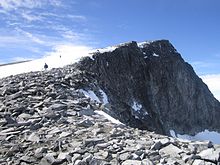

The most isolated major summits of Europebytopographic isolation are located in the European continent and its tectonic and geographic boundaries. This includes major mountain peaks of fold and fault-block mountains, and also volcanoes,[1] located not only in the European Mainland, but also those located on lands and islands on the limits of Europe, like the North Atlantic Ocean islands of the Azores and Iceland, the Arctic Ocean islands of Jan Mayen, Svalbard archipelago and Novaya Zemlya archipelago, the Mediterranean island of Sicily, the Ural Mountains, and Mount Elbrus. The last mentioned is HP of the transboundary Caucasus Mountains and Greater Caucasus region, but as a geologically separate stratovolcano, it is entirely laying in Europe (and Russia), 20 km (12 mi) north of the main ridge of the Greater Caucasus, considered as the one that is forming the limits of Europe. The definition excludes island clearly lying on the African Plate and outside the geographic limits of Europe, like the Canaries and Madeira. The active volcano of Mount Etna is somehow on, or just outside the boundaries of the Eurasian Plate, resting on the subduction boundary where the African tectonic plate is being pushed under the Eurasian plate, but geographically is part of Europe, and is also included in the Top 10 lists.

